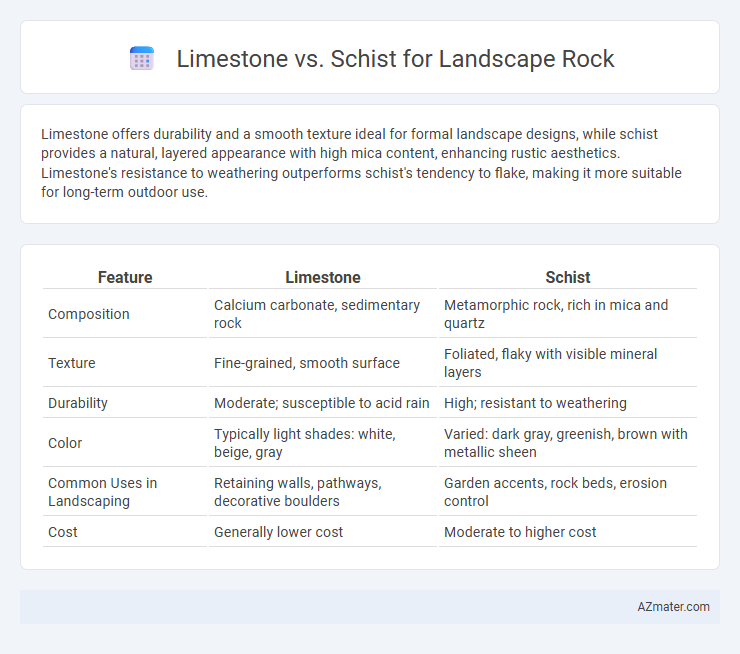Limestone offers durability and a smooth texture ideal for formal landscape designs, while schist provides a natural, layered appearance with high mica content, enhancing rustic aesthetics. Limestone's resistance to weathering outperforms schist's tendency to flake, making it more suitable for long-term outdoor use.
Table of Comparison
| Feature | Limestone | Schist |
|---|---|---|
| Composition | Calcium carbonate, sedimentary rock | Metamorphic rock, rich in mica and quartz |
| Texture | Fine-grained, smooth surface | Foliated, flaky with visible mineral layers |
| Durability | Moderate; susceptible to acid rain | High; resistant to weathering |
| Color | Typically light shades: white, beige, gray | Varied: dark gray, greenish, brown with metallic sheen |
| Common Uses in Landscaping | Retaining walls, pathways, decorative boulders | Garden accents, rock beds, erosion control |
| Cost | Generally lower cost | Moderate to higher cost |
Introduction to Limestone and Schist
Limestone is a sedimentary rock composed primarily of calcium carbonate, known for its durability and light color that ranges from white to tan, making it a popular choice for landscaping and garden features. Schist is a metamorphic rock characterized by its foliated texture and rich mineral content, often showcasing shiny mica flakes and varying colors that add unique visual interest to outdoor spaces. Both rocks offer distinct aesthetic and structural benefits, with limestone providing a classic, smooth appearance and schist delivering a textured, natural look ideal for diverse landscape designs.
Geological Formation and Characteristics
Limestone forms primarily from the accumulation of marine organisms' calcium carbonate shells, resulting in a sedimentary rock with a fine to coarse texture that often reacts with acid due to its calcite content. Schist originates from regional metamorphism of mudstone or shale, displaying a foliated texture with visible mica flakes that provide a glittering appearance and enhanced durability. Limestone's porosity can lead to weathering in wet climates, while schist's foliated layers may cause splitting but offer greater resistance to physical erosion in landscape applications.
Aesthetic Differences: Color and Texture
Limestone offers a subtle palette with soft whites, creams, and light grays, featuring a smooth to fine-grained texture that creates an elegant, uniform appearance in landscape design. Schist presents a more varied and dramatic aesthetic, boasting rich, dark hues like deep grays, greens, and browns, along with a distinctly foliated, flaky texture that adds rugged visual interest and depth. The choice between limestone and schist significantly impacts the overall mood of outdoor spaces, with limestone favoring timeless simplicity and schist emphasizing natural complexity.
Durability and Weather Resistance
Limestone offers moderate durability and weathers relatively well but is prone to erosion and surface wear over time in harsh climates. Schist exhibits superior durability with natural foliated layers providing enhanced resistance to weathering and physical stress, making it more suitable for long-term landscape applications. Choosing schist ensures greater longevity and minimal maintenance in exposed outdoor environments compared to limestone.
Maintenance Requirements
Limestone requires regular sealing to prevent staining and erosion, especially in acidic or wet environments, making maintenance more intensive over time. Schist's foliated texture and natural cleavage make it more resistant to weathering and easier to clean without frequent sealing, reducing overall upkeep. Both materials benefit from occasional debris removal and inspections, but schist generally demands less ongoing maintenance in landscape applications.
Cost Comparison
Limestone typically costs between $50 and $75 per ton, making it a more budget-friendly option for landscape rock compared to schist, which ranges from $80 to $120 per ton due to its unique texture and durability. Schist's higher price reflects its natural layering and aesthetic appeal, often favored for premium garden designs. Choosing limestone offers a cost-effective solution while maintaining versatility for various landscaping applications.
Environmental Impact
Limestone extraction typically results in higher carbon emissions due to its intensive quarrying process and the release of carbon dioxide during calcination, whereas schist mining generally has a lower environmental footprint as it involves less chemical alteration and simpler extraction methods. Both materials can impact local ecosystems by disrupting habitats and causing soil erosion; however, schist's natural foliated structure allows for better water drainage and reduced runoff compared to limestone's more soluble composition. Choosing schist over limestone for landscape rock can lead to improved sustainability by minimizing chemical leaching and supporting long-term soil stability.
Installation Considerations
Limestone's softer texture allows for easier cutting and shaping, making installation more straightforward in landscape rock projects, while schist's layered, foliated structure can complicate placement due to its natural splitting tendencies. Proper base preparation is crucial for both, but schist requires additional stabilization to prevent shifting or crumbling over time, especially in high-traffic areas. Drainage considerations are important with limestone, as its porosity can affect water flow and longevity in garden beds or pathways.
Best Uses in Landscaping
Limestone offers versatility in landscaping, ideal for garden paths, retaining walls, and decorative rock beds due to its durability and light color variations that complement various plantings. Schist, with its foliated texture and rich, earthy tones, is best suited for accents in rock gardens, natural stone steps, and water features where its layering adds visual interest and enhances natural aesthetics. Choosing between limestone and schist depends on the desired texture, durability, and color palette to create harmonious outdoor spaces.
Choosing the Right Stone for Your Project
Limestone offers a classic, uniform appearance with neutral tones ideal for formal landscape designs, while schist provides a textured, layered surface with natural metallic flecks, adding rustic charm and visual interest. Consider limestone's durability and resistance to weathering for paths and retaining walls, whereas schist's foliated structure is better suited for decorative rock gardens and naturalistic settings. Evaluate project-specific factors like climate, desired aesthetic, and maintenance requirements to select the stone that enhances both functionality and beauty in your landscape.

Infographic: Limestone vs Schist for Landscape Rock
 azmater.com
azmater.com